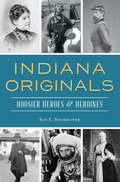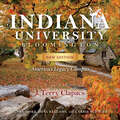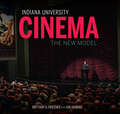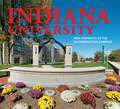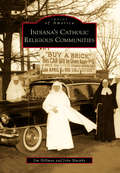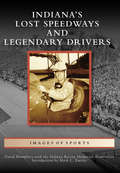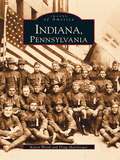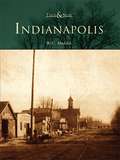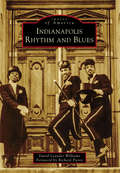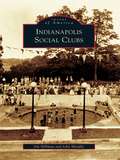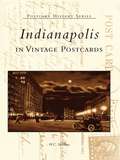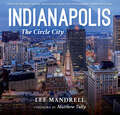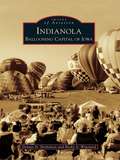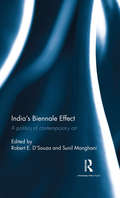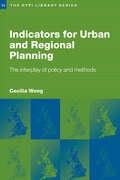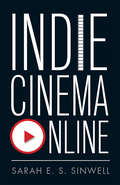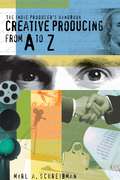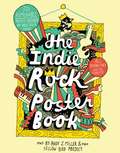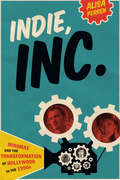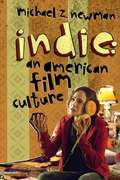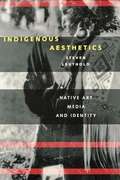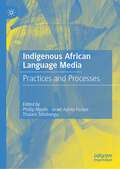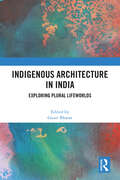- Table View
- List View
Indiana Covered Bridges: Indiana's Covered Bridge Capital
by Rachel Berenson Perry Marsha Williamson MohrA symbol of Indiana's past, the covered bridge still evokes feelings of nostalgia, romance, and even mystery. During the 19th century, over 500 of these handsome structures spanned the streams, rivers, and ravines of Indiana. Plagued by floods, fire, storms, neglect, and arson, today fewer than 100 remain. Marsha Williamson Mohr's photographs capture the timeless and simple beauty of these well-traveled structures from around the state, including Parke County--the unofficial covered bridge capital of the world. With 105 color photographs, Indiana's Covered Bridges will appeal to everyone who treasures Indiana's rich architectural heritage.
Indiana Originals: Hoosier Heroes & Heroines
by Ray E. BoomhowerHoosier history overflows with bold visionaries, noble heroes and lovable rogues. May Wright Sewall struggled to uplift womankind and unflinchingly called for peace in a world sleepwalking toward conflict. In the guise of Abe Martin, Kin Hubbard graced the Indianapolis News's back page for twenty-six years with folksy humor. Combat photographer John A. Bushemi bravely faced the terrors of war and perished capturing its violence. Audacious automotive pioneer Carl G. Fisher went to any length to promote himself, even flying a car via a hot-air balloon. Drawing on more than thirty years of experience, author Ray E. Boomhower, the dean of Hoosier biographers, brings together forty of the most notable figures from the nineteenth state.
Indiana University Bloomington: America's Legacy Campus (Well House Books)
by J. Terry Clapacs Susan Moke Dina Kellams Carrie SchwierAmid the forested hills of southern Indiana stands one of America's most beautiful college campuses. Indiana University Bloomington: America's Legacy Campus, the new edition, returns the reader to this architectural gem and cultural touchstone. Revised and updated to include new buildings and features of campus life, it is a must have for any Hoosier. The IU Bloomington campus, rich in architectural tradition, harmonious in building scale and materials, and surrounded by natural beauty, stands today as a testimony to careful campus planning and committed stewardship. Planning principles adopted in the very early stages of campus development have been protected, enhanced, and faithfully preserved, resulting in an institution that can truly be called America's Legacy Campus. Lavishly illustrated and brimming with fascinating details, this book tells the story of Indiana University—a tale not only of buildings, architecture, and growth, but of the talented, dedicated people who brought the buildings to life. Completely updated with new buildings and an epilogue, and now even more lavishly illustrated, this new edition is a lasting tribute to the treasure that is Indiana University Bloomington.
Indiana University Cinema: The New Model (Well House Books)
by Brittany D. Friesner Jon VickersIn its first ten years, a small Midwestern cinema has attracted some of the most intriguing and groundbreaking filmmakers from around the world, screened the best in arthouse and repertory films, and presented innovative and unique cinematic experiences.Indiana University Cinema tells the story of how the cinema on the campus of Indiana University Bloomington grew into a vibrant, diverse, and thoughtfully curated cinematheque. Detailing its creation of a transformative cinematic experience throughout its inaugural decade, the IU Cinema has arguably become one of the best venues for watching movies in the country. Featuring 17 exclusive interviews with filmmakers and actors, as well as an afterword from Jonathan Banks (Breaking Bad and Better Call Saul), Indiana University Cinema, is a lavishly illustrated book that is sure to please everyone from the casual moviegoer to the most passionate cinephile.
Indiana University: New Portraits of the Bloomington Campus
by Kendall ReevesSet in the rolling hills of southern Indiana, Indiana University Bloomington is widely acknowledged to be one of the most picturesque college campuses in the United States Indiana University: New Portraits of the Bloomington Campus offers Hoosiers the chance to discover or revisit the campus for themselves and appreciate stunning new buildings and improvements in landscaping and facilities. During its two-hundred-year history, the Bloomington campus has grown out from its original core while maintaining its focus on its architectural atheistic. Indiana University Bloomington now occupies nearly 2,000 acres, and the beauty and harmony of its limestone buildings set against breathtaking natural scenery make the campus a treasure that all Hoosiers enjoy.Indiana University: New Portraits of the Bloomington Campus offers Hoosiers the chance to travel back home, relive past friendships, scholarly achievements, Little Fives, and Hoosier victories, and wander again, if just for a moment, through Dunn's Woods, the Cox Arboretum, and the iconic Sample Gates.
Indiana's Catholic Religious Communities
by John Murphy Jim HillmanWith expanding Irish, Swiss, French, and German immigrant populations, the state of Indiana evolved from individual explorers, trappers, hunters, and traders into family-focused communities of farmers and craftsmen. Emerging from the former Indiana Territory, the state's early population was in need of education, health care, and social services to assist young families, the poor, the infirm, and the elderly. These needs were frequently met by Catholic religious orders, including the Benedictines, Sisters of Providence, Franciscans, Daughters of Charity, and other established organizations of dedicated religious men and women.
Indiana's Lost Speedways and Legendary Drivers (Images of Sports)
by David HumphreyFrom the Indianapolis 500 Motor Speedway to the dirt oval tracks in small Indiana towns, thousands of Hoosiers frequent the raceway of their choice each year. Today, there are an estimated 40 asphalt, clay, and dirt-covered oval tracks in Indiana where race fans cheer local drivers, often navigating jalopies pieced together from junkyard parts, to victory lane. Though many racetracks remain in operation throughout the state, dozens have fallen to the wayside over the past 100 years. Forever in remembrance are the famous and not so famous Indiana-born drivers who thrilled fans at those now defunct tracks. Evansville native Charlie Wiggins won the Gold and Glory Sweepstakes four times. Bob Kinser from Bloomington raced over 40 years and is an inductee of the National Sprint Car Hall of Fame, and Tom Cherry of Muncie won the Little 500 four times.
Indiana, Pennsylvania
by Karen Wood Doug MacgregorNestled in the hills of scenic western Pennsylvania, the borough of Indiana is a center of learning and the seat of county government. Incorporated in 1816, the borough lies in the heart of the state's bituminous coal region. Indiana has been home to a wide variety of industries and businesses, from breweries and lumber companies to higher education and Christmas tree farms. Among thousands of successful families and individuals, Indiana is famous as the home of actor Jimmy Stewart, Gov. John S. Fishe, and author Ed Abbey.Indiana, Pennsylvania is a compilation of stunning photographs that reveal a historical community. Included in this valuable history are the secret connections to the Underground Railroad, the arrival of electricity and telephones, the first automobiles, and the last Civil War veteran. Indiana, Pennsylvania also features many parts of the borough that have vanished, such as Indiana's early buildings and most of the old downtown hotels.
Indianapolis
by W. C. MaddenInaugurated as the state capital in 1825, Indianapolis was patterned after the nation's capital and laid out on a mile-square grid with Monument Circle at its center. As the city grew and experienced the tumult of the Civil War, legislators decided to erect a monument to the war's fallen servicemen. In 1902, one of the world's most outstanding memorials was completed-the Soldiers and Sailors Monument. Surrounding Monument Circle, "The Circle City" gets its nickname from the prominence and historical significance of the central city structure. Throughout the years, Indianapolis has maintained its commitment to honoring the achievements of Hoosiers. This dedication to Indiana has given the capital its own rich history, told not only through monuments and memorials, but also through the architecture, parks, businesses, and people that make up the heart of Indianapolis. This new book documents the heroes and history of the city, using an impressive collection of vintage photographs from the late 1800s through the early 1900s juxtaposed against present-day images.
Indianapolis Rhythm and Blues (Images of America)
by David Leander WilliamsIndiana Avenue was traditionally the host to some of America's premier, world-renown entertainment icons in various genres. Along this winding, brightly lit thoroughfare were nightclubs, lounges, supper clubs, taverns, juke joints, and holes-in-the-wall that celebrated the best of the best in entertainment that America had to offer, from the 1920s on into the 1970s. On the bandstand at Denver Ferguson's Sunset Terrace Ballroom, the elegantly attired crooner Nat King Cole, in a sparkling blue silk suit, delivered his signature song "Mona Lisa." Nearby, B.B. King sang his 1973 down-home blues classic "To Know You is to Love You." At Tuffy Mitchell's Pink Poodle nightclub, "Moms" Mabley made the audience roar with laughter during her sidesplitting comedy routine. Indiana Avenue truly was the place to be for the best in entertainment.
Indianapolis Social Clubs (Images of America)
by John Murphy Jim HillmanMore than banquet halls, golf courses, and swimming pools, social clubs were a haven for businessmen, politicians, and community leaders, offering respite from public scrutiny. Defining Indianapolis, the clubs were stoic agents of power and segregation, providing clear historical snapshots of Hoosier pomp and circumstance. The clubs did more than produce Olympic swimmers, world-class golfers, and tennis professionals; they were Indianapolis's multigenerational playgrounds. There were the politics and business dealings at the Columbia Club and the Indianapolis Athletic Club, the golfing, tennis, and formality of Woodstock, Meridian Hills, and other country clubs, and the family fun in the sun at Riviera, Devon, and Olympia. These organizations offered more than magical summers with family and friends; they were the places to be seen.
Indianapolis in Vintage Postcards (Postcard History)
by W. C. MaddenIn the late 1800s, postcards of Indianapolis began appearing in mailboxes throughout the country. Since that time, the many prominent monuments, buildings, and parks of the Hoosier capital have been featured on countless cards.Using an impressive collection of these images, author W.C. Madden takes the reader on an historic journey through Indianapolis from 1890 to 1950, providing a visual history of the development of the city. Indianapolis experienced great growth during the first half of the 20th century, which gave rise to innovative art and architectural structures, many that serve as the subject of postcards featured here. The Soldiers and Sailors Monument, the Indiana World War Memorial, the Indianapolis Motor Speedway, Union Station, and Claypool Hotel, to name a few, are all highlighted.
Indianapolis: The Circle City
by Lee MandrellA beautifully photographed tour of the Indiana capital from city streets to state fairs to the world’s biggest Christmas tree.Indianapolis shines like never before in this one-of-a-kind book filled with stunning images. Photographer Lee Mandrell showcases a Circle City of unique architecture and natural areas, outstanding museums, and historic landmarks. Readers will be drawn into the rich culture, history, and art of Indianapolis as well as all things modern.Stroll along the famous Canal Walk. Explore the largest children’s museum in the world. Wander through the city’s parks and enjoy beautiful seasonal displays. Marvel at the campuses of Butler University and IUPUI—and see the two hundred eighty-four-foot-tall Soldiers and Sailors Monument covered in lights and the world’s largest Christmas tree.“This book will inspire with joy and reverence a greater love of Indianapolis.” —Senator Dick Lugar
Indianola: Ballooning Capital of Iowa (Images of Aviation)
by Dennis D. Nicholson Becky S. WigelandIndianola, founded in 1849, is the county seat of Warren County, Iowa. It is located 12 miles south of Iowa's capital, Des Moines, at the intersection of U.S. highways 65 and 69 and state highway 92. The city is home of the National Balloon Museum, begun in 1972; the National Balloon Classic, an annual nine-day balloon rally; the Balloon Federation of America's national office; Simpson College; the Des Moines Metro Opera, a widely acclaimed summer opera festival; and is host to the Iowa Wine Festival each summer. This book focuses on the history of ballooning in Indianola, which hosted the U.S. National Hot Air Balloon Championships from 1970 to 1988, and the National Balloon Classic from 1989 to the present. This is the story of how Indianola became the ballooning capital of Iowa.
India’s Biennale Effect: A politics of contemporary art
by Sunil Manghani Robert E. D'SouzaIndia’s Kochi-Muziris Biennale has been described as one of the most significant newly emergent biennales, alongside Shanghai, Sharjah and Dakar. However, there have been few sustained and critical studies of these events as specific sites of production and reception of contemporary art. This book, engaging with the Kochi Biennale, provides detailed examination of what the editors term as the ‘biennale effect’ — a layered contestation of place, economics, art and politics. It presents a close reading of the unique context of the biennale as well as sets out a broader critical framework for understanding global contemporary art and its effects. Replete with illustrations, this book will serve as an important and rare resource for scholars and researchers of contemporary art, art history, visual cultures, and media studies.
Indicators for Urban and Regional Planning: The Interplay of Policy and Methods (RTPI Library Series)
by Cecilia WongThis book focuses on the measurement and utilisation of quantitative indicators in the urban and regional planning fields. There has been a resurgence of academic and policy interest in using indicators to inform planning, partly in response to the current government's information intensive approach to decision-making. The content of the book falls into three broad sections: indicators usage and policy-making; methodological and conception issues; and case studies of policy indicators.
Indie Cinema Online
by Sarah E.S. SinwellIndie Cinema Online investigates the changing nature of contemporary American independent cinema in an era of media convergence. Focusing on the ways in which modes of production, distribution, and exhibition are shifting with the advent of online streaming, simultaneous release strategies, and web series, this book analyzes sites such as SundanceTV, YouTube, Netflix, Hulu, and other online spaces as a means of redefining independent cinema in a digital era. Analyzing the intersections among cinema studies, cultural studies, and new media studies within contemporary convergence culture, author Sarah E.S. Sinwell looks at sites of media convergence that are often ignored within most studies of digital media. Emphasizing the ways in which the forms and technologies of media culture have changed during the age of convergence, this book analyzes contemporary production, distribution, and exhibition practices as a means of examining the changing meanings of independent cinema within digital culture.
Indie Producers Handbook: Creative Producing from A to Z
by Myrl A. SchreibmanSchreibman, a film professor and administrator at the University of California Los Angeles School of Theater, Film and Television, gives practical, step-by-step directions for organizing and running a film from budgeting and pre-production through post-production and delivery, and offers engaging anecdotes from his 15 years of film, television, and theater projects to illustrate points. He describes the varied elements that go into making a film, and details the producer's role of bringing these elements together. Annotation c. Book News, Inc., Portland, OR (booknews.com)
Indie Rock Poster Book
by Yellow Bird Project Andy J. MillerFrom the authors of the popular Indie Rock Coloring Book, this poster book is a colorful celebration of indie rock music and art. Showcasing original artwork by thirty of today's cutting-edge illustrators--including Mike Perry, Deanne Cheuk, Jeremyville, Andy J. Miller, and more--this poster collection is inspired by classic indie rock songs of each artist's choosing. Featuring such favorite indie rock acts as the Bon Iver, Devendra Banhart, and Iron & Wine, this book is a must-have for indie art and music fans. Plus, it's all for a good cause: royalties go to the host of admirable charities supported by Yellow Bird Project.
Indie, Inc.: Miramax and the Transformation of Hollywood in the 1990s (Texas Film and Media Studies Series)
by Alisa PerrenDuring the 1990s, films such as sex, lies, and videotape, The Crying Game, Pulp Fiction, Good Will Hunting, and Shakespeare in Love earned substantial sums at the box office along with extensive critical acclaim. A disproportionate number of these hits came from one company: Miramax. Indie, Inc. surveys Miramax&’s evolution from independent producer-distributor to studio subsidiary, chronicling how one company transformed not just the independent film world but the film and media industries more broadly. As Alisa Perren illustrates, Miramax&’s activities had an impact on everything from film festival practices to marketing strategies, talent development to awards campaigning. Case studies of key films, including The Piano, Kids, Scream, The English Patient, and Life Is Beautiful, reveal how Miramax went beyond influencing Hollywood business practices and motion picture aesthetics to shaping popular and critical discourses about cinema during the 1990s. Indie, Inc. does what other books about contemporary low-budget cinema have not—it transcends discussions of &“American indies&” to look at the range of Miramax-released genre films, foreign-language films, and English-language imports released over the course of the decade. The book illustrates that what both the press and scholars have typically represented as the &“rise of the American independent&” was in fact part of a larger reconfiguration of the media industries toward niche-oriented products.
Indie: An American Film Culture
by Michael Z. NewmanFrom Stranger than Paradise (1984) to Synecdoche, New York (2008), America's independent films often seem to defy classification. Their strategies of storytelling and representation vary widely, and they range from raw, no-budget productions to the more polished releases of Hollywood's "specialty" divisions. Understanding American indies involves more than just considering films. Filmmakers, distributors, exhibitors, festivals, critics, and audiences play a role in the art's identity, which is always understood in relation to the Hollywood mainstream. By locating the American indie in the historical context of the Sundance-Miramax era (the mid-1980s to the end of the 2000s), Michael Z. Newman considers indie cinema as an alternative American film culture. His work isolates patterns of character and realism, formal play, and oppositionality in these films and the function of festivals, art houses, and critical media in promoting them. He accounts for the power of audiences to distinguish indie films from mainstream Hollywood and to seek socially emblematic characters and playful form in their narratives. Analyzing films such as Welcome to the Dollhouse (1996), Lost in Translation (2003), Pulp Fiction (1994), and Juno (2007), along with the work of Nicole Holofcener, Jim Jarmusch, John Sayles, Steven Soderbergh, and the Coen brothers, Newman investigates the conventions that cast indies as culturally legitimate works of art and sustain these films' appeal. In doing so, he not only binds these diverse works together within a cluster of distinct viewing strategies but also invites readers to reevaluate the difference of independent cinema, as well as its relationship to class and taste culture.
Indie: An American Film Culture (Film and Culture Series)
by Michael Z. NewmanAmerica's independent films often seem to defy classification. Their strategies of storytelling and representation range from raw, no-budget projects to more polished releases of Hollywood's "specialty" divisions. Yet understanding American indies involves more than just considering films. Filmmakers, distributors, exhibitors, festivals, critics, and audiences all shape the art's identity, which is always understood in relation to the Hollywood mainstream.By locating the American indie film in the historical context of the "Sundance-Miramax" era (the mid-1980s to the end of the 2000s), Michael Z. Newman considers indie cinema as an alternative American film culture. His work isolates patterns of character and realism, formal play, and oppositionality and the functions of the festivals, art houses, and critical media promoting them. He also accounts for the power of audiences to identify indie films in distinction to mainstream Hollywood and to seek socially emblematic characters and playful form in their narratives. Analyzing films such as Welcome to the Dollhouse (1996), Lost in Translation (2003), Pulp Fiction (1994), and Juno (2007), along with the work of Nicole Holofcener, Jim Jarmusch, John Sayles, Steven Soderbergh, and the Coen brothers, Newman investigates the conventions that cast indies as culturally legitimate works of art. He binds these diverse works together within a cluster of distinct viewing strategies and invites a reevaluation of the difference of independent cinema and its relationship to class and taste culture.
Indigenous Aesthetics: Native Art, Media, and Identity
by Steven LeutholdWhat happens when a Native or indigenous person turns a video camera on his or her own culture? Are the resulting images different from what a Westernized filmmaker would create, and, if so, in what ways? How does the use of a non-Native art-making medium, specifically video or film, affect the aesthetics of the Native culture?<P><P>These are some of the questions that underlie this rich study of Native American aesthetics, art, media, and identity. Steven Leuthold opens with a theoretically informed discussion of the core concepts of aesthetics and indigenous culture and then turns to detailed examination of the work of American Indian documentary filmmakers, including George Burdeau and Victor Masayesva, Jr. He shows how Native filmmaking incorporates traditional concepts such as the connection to place, to the sacred, and to the cycles of nature. While these concepts now find expression through Westernized media, they also maintain continuity with earlier aesthetic productions. In this way, Native filmmaking serves to create and preserve a sense of identity for indigenous people.
Indigenous African Language Media: Practices and Processes
by Phillip Mpofu Thulani Tshabangu Israel Ayinla FadipeThe book contributes to the sparse academic literature on African and minority language media research. It serves as a compendium of experiences, activities and case studies on the use of native language media. Chapters in this book make theoretical, methodical and empirical contributions about indigenous African language media that are affected by structural factors of politics, technology, culture and economy and how they are creatively produced and appropriated by their audiences across African cultures and contexts. This book explores indigenous African language media about media representations, media texts and contents, practice-based activities, audience reception and participation, television, popular culture and cinema, peace and conflict resolution, health and environmental crisis communication, citizen journalism, ethnic and identity formation, beat analysis and investigative journalism, and corporate communication. There are hardly any similar works that focus on the various issues relating to this body of knowledge. The book provides a valuable companion for scholars in various fields like communication, media studies, African studies, African languages, popular culture, journalism, health and environmental communication.
Indigenous Architecture in India: Exploring Plural Lifeworlds
by Gauri BharatThis volume focuses on socio- spatial practices of indigenous communities in India. It explores the interrelation between the built environments and lifeworlds, i.e. practices, patterns, and structures of everyday life. The chapters deal with different ideas and definitions of indigeneity, while also addressing the complex equations between the production and perception of built forms, indigenous technologies, on the one hand, and social, environmental and political contexts, questions of aesthetics, identity, and self-representation on the other.From Adivasi art and sacred sites to craft villages and nomadic pastoralists in western India, from indigenous bangle makers in urban north India to terracotta crafts people on the south, each chapter focuses on different communities and the contours of their contemporary lifeworlds. The contributions actively attempt to foreground the logic and perspectives of the communities themselves as the epistemological centre of the architectural and material discourses on indigeneity.This book will be useful for students, teachers, and researchers of architecture, urban design, urban studies, urban development and planning, anthropology, sociology, and museum studies. It will also be of interest to urban planners and designers, policy planners, local government authorities, and professionals engaged in the discipline.

